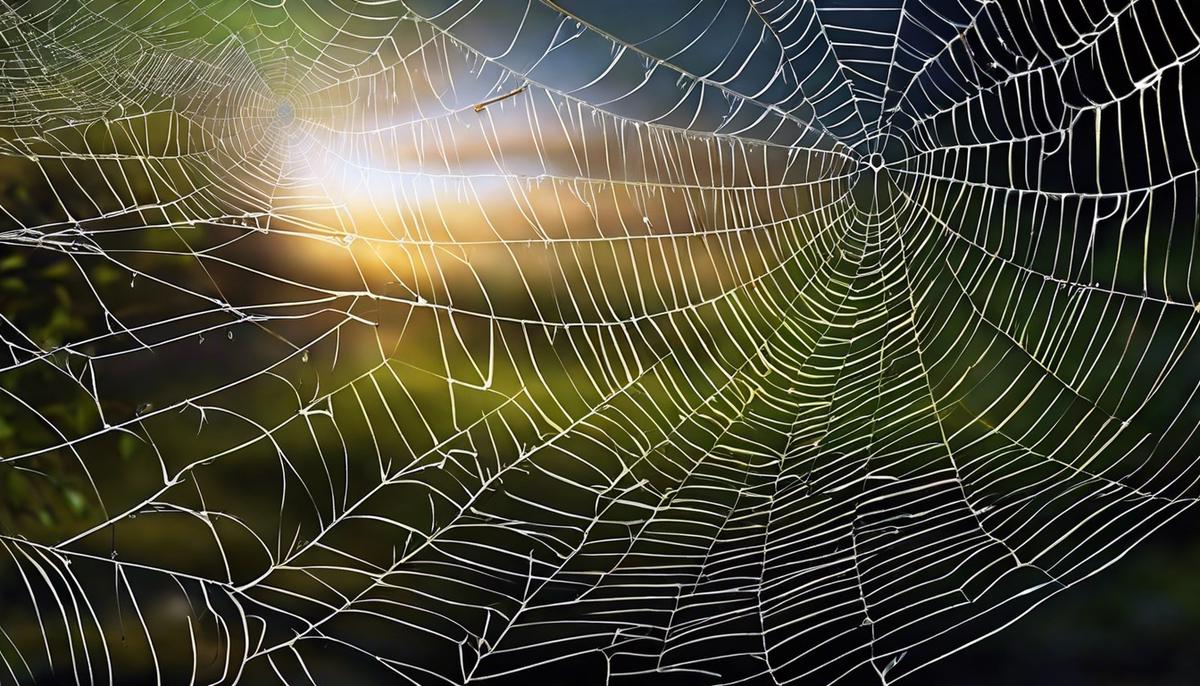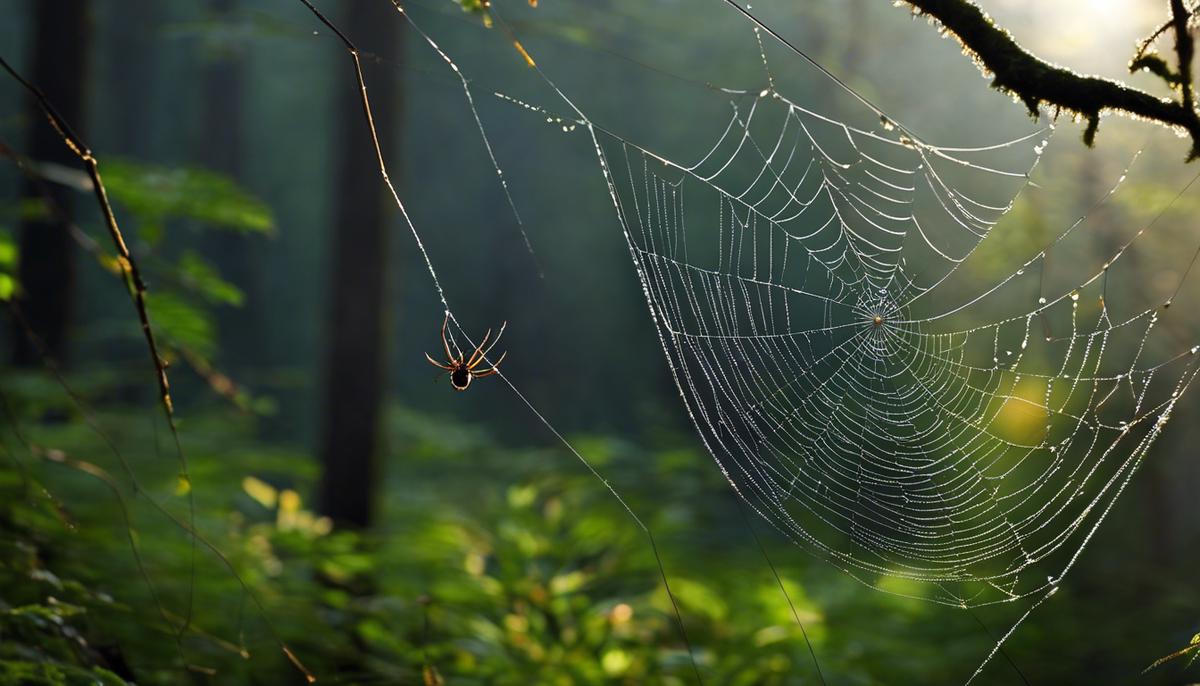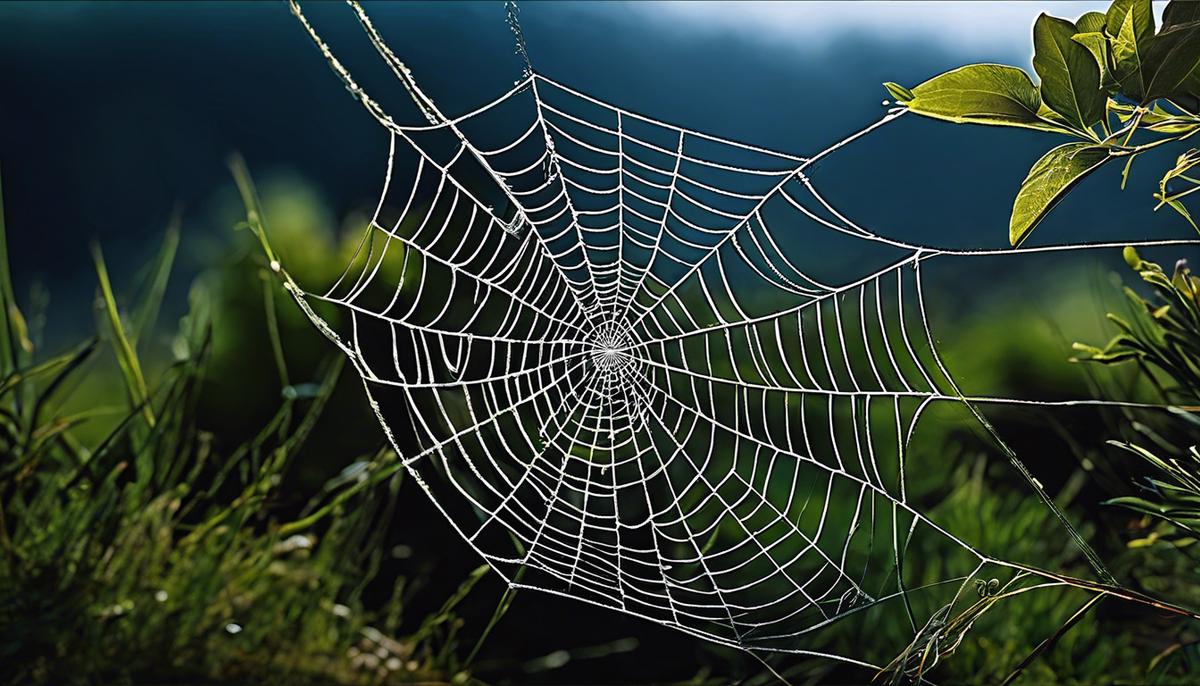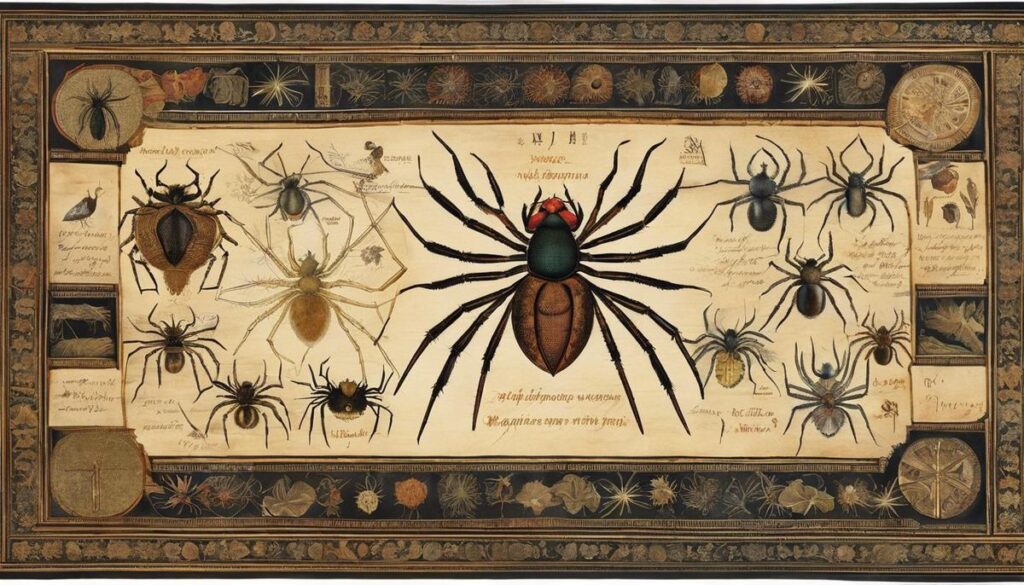Our dreams can often act as windows into our subconscious, revealing complex symbolisms that bear significant interpretations. One commonly recurring dream theme is that of spiders and their elaborate webs. Throughout history, spiders and their web-spinning abilities have held important symbolic meanings in various cultures and texts, including the Bible. This essay presents a comprehensive exploration of the symbolism of spiders and spider webs in dreams from both a biblical and psychological perspective. Historical contexts and modern theories intertwine to disclose the multifaceted and nuanced meanings these occasionally unnerving, yet intricate dreams may hold.
Symbolism of Spiders in Ancient Texts
“Arachnological Artifacts: An Examination of Spider Symbolism in Ancient Texts”
Spiders are ubiquitous across the globe – inhabiting every continent except Antarctica, thus it is unsurprising that these vibrant yet elusive creatures have found their way into the pantheon of symbolism in ancient texts. Narrowing down the complex and layered tapestry of centuries-old narratives, this article seeks to shine a light on the historical context and interpretation of spiders in several crucial and influential ancient texts.
Starting with the richly textured ancient Greek mythology, Arachne, a skilled mortal weaver, was transformed into a spider by Athena, the goddess of wisdom and crafts. This well-documented myth offers a pivotal perspective on the perception of spiders—inextricably tied to themes of craft, wisdom, hubris, and divine retribution.
Turning our gaze to the ancient dynasties of China, spiders were associated with mysticism and tales of re-birth. Adopting a different route, the Native American tribes perceived the spider as a ‘culture hero’. From the Hopi creation story to the Navajo traditions, the arachnid is revered as a figure of wisdom and inventor of writing. In certain tribes like the Ojibwa, the human dream world was beleaguered by bad dreams, saved only by the creation of ‘Spider Woman’s’ dreamcatchers, embodying not only creativity but also the benevolence of spiders.
Exploring ancient Egyptian texts, a more nuanced depiction emerges, where the spider is seen as a representation of Neith, a goddess associated with weaving, water, and war – variegating the spectrum of spider symbolism.
Perhaps the most enduring depiction comes from West African traditions where the spider, as Anansi, is a trickster figure, a storyteller and a symbol of rebellion against authority. This figure has had profound influence, meandering through time and space to feature prominently in the folk tales of the American south post diaspora.
Meanwhile, in Buddhism, the spider’s web is a powerful metaphor for the illusionary physical world we inhabit, brilliantly capturing in its intricate design, the consequences of our choices and actions – reverberating the tenets of karma.
Backtracking to the onset of Christianity, spiders were often seen in a negative light, associated with evil, temptation, and treachery. This might have been reinforced by the Black Death in the 14th century, during which spiders, unjustifiably, were blamed as vectors for the plague. Though, on a better note, folklore also heralds the spider as a symbol of good luck – a divine creature that spun a protective web to hide infant Jesus from King Herod.
In a synopsis, the interpretation of spiders in ancient texts is as diverse as the numerous species dotting our planet, each cultural lens offering a unique view. From wisdom to deceit, craft to divine connection, the metaphoric spider weaves a web across cultures and ages. As research unfolds, so does our understanding of these complex symbolisms that not only inform about our past but also cast a shadow on our perceptions today.

Spider Webs in Dreams: Psychological Perspective
Drawing from a wealth of historical viewpoints on arachnids and their captivating creations elucidated above, the examination is now shifted towards the realm of contemporary psychology.
The appearance of spider webs in dreams, under the lens of modern psychological theories, often presents a multilayered significance tied to the individual’s cognitive, psychological, and emotional state.
As a starting point, Carl Jung’s school of analytic psychology accords substantial significance to spider webs in dreams. Known for his theory of the collective unconscious, archetypes, and dream analysis, Jung characterized spider webs as powerful symbols in the unconscious people’s minds.
In this realm, the spider web often represents feminine power or the concept of the ‘anima,’ which is the unconscious feminine side in men. It also calls attention to the dreamer’s relationship with their ‘shadow,’ the relatively unknown and problematic aspects of the personality. The intricacy of the web can signal a complex situation in the dreamer’s life or a feeling of being ensnared in an overpowering emotional, psychological, or social scenario.
On the other hand, cognitive psychology, particularly the Activation-Synthesis Hypothesis proffered by J. Allan Hobson and Robert McCarley, provides a different interpretation.
They posit that dreams—including those featuring spider webs—are random neuronal firing during REM sleep, which the brain struggles to form into coherent narratives upon waking. Hence, the presence of spider webs may not necessarily symbolize significant psychological themes but could just be a reflection of daily encounters or lingering thoughts being formulated into dream content.
Complementing this biological viewpoint is the cognitive process dream theory, which suggests dreams are cognitive processes that serve as the subconscious continuation of our conscious thoughts and emotions.
Thus, spider webs making their way into our dreams could be an indication of our mind grappling with complex, intricate issues or relationships requiring delicate navigation, mirroring the inherent intricacies of the web itself.
In stark contrast to both cognitive and Jungian viewpoints, Gestalt psychology envisages dreams as a manifestation of the whole self, both conscious and unconscious.
According to Fritz Perls, the founder of this school, each element of the dream, including spider webs, is a reflection of the dreamer’s emotions and personality.
This perspective prompts the individuals to interact with the dream spider web, perhaps untangling or navigating it, to understand their unresolved tensions and conflicts.
In the fascinating realm of dream analysis, where psychological theories intersect with the individual’s subjective experiences and emotional life, the appearance of spider webs can portray a wide range of meanings.
It could symbolize complex entanglements, suppressed aspects of the self, the continuity of daily cognition, or the holistic representation of the self, depending on the theoretical lens through which it is examined.
The diversity and intricacy of interpretations hearken back to the rich tapestry of spider-symbolism uncovered across historical cultures, reinforcing the enduring allure of these intrepid, industrious creatures and their mesmerizing creations.

Combining the Biblical and Psychological Views
In the analysis of dreams, both biblical and psychological interpretations play key roles. While often interpreted differently based on cultural backgrounds, the specific symbolism of spider webs in dreams forms an intriguing topic of study.
In the biblical interpretation, the symbolism of spider webs is notably multi-dimensional. As a thread-forming entity, the spider’s web is often regarded as an embodiment of vanity, frailty, or deceit, with a particular instance found in the book of Isaiah 59:5-6 where the webs are declared not fit for clothing nor will they cover oneself. This visual metaphor of fragility resonates in Job 8:14, where the trust in emptiness is compared to a spider’s web. Profoundly, even within biblical illustrations, the symbolism is vast and varied.
Contrastingly, the psychological interpretations of spider webs, particularly Freudian and Jungian philosophies, tend to delve into intricate layers of an individual’s subconscious. In Jung’s school of analytic psychology, the spider web is perceived to represent the dreamer’s relationship with their “shadow,” or unexploded aspects of their personality.
Parallely, spider webs can be seen as symbols of feminine power, embodying a male dreamer’s unconscious feminine side, known as the ‘anima’ within Jungian analysis. Conversely, a female dreamer interacting with the spider web may be engaging with her ‘animus’, or unconscious masculine side. This interpretive level of dream analysis provides a rich terrain for exploring gender identity and dynamics within a dreamer’s psychological profile.
For dreamers feeling trapped or overwhelmed, the complexity of the spider web could symbolize entanglement in complex situations or emotions. This is manifested as the web’s intricate design evoking feelings of subordination or confusion, highlighting a need for self-understanding and resolution.
In the domain of neurobiology, the Activation-Synthesis Hypothesis asserts that dreams, including those containing spider webs, are the result of random neuronal firing during the REM or ‘dreaming’ stage of sleep. Here, the spider web might not carry a deeper meaning, but rather a reflection of the dreamer’s daily encounters or thoughts amalgamated into dream content through random neural connectivity.
In concurrence with the cognition theory which posits dreams as a continuation of subconscious thoughts and emotions, spider webs can represent intricate issues or relationships explored in the dream state. From a Gestalt perspective that posits dreams as manifestations of the whole self, interacting with dream spider webs can facilitate a profound understanding of unresolved tensions and conflicts.
In sum, the symbolism of spider webs in dreams teems with potential interpretations from a biblical and psychological perspective. The quest for meaning in the realm of sleep continues to herald discussions from scholars and enthusiasts alike. Presenting different theoretical lens through which they are observed, spider webs in dreams entail a wide-ranging panorama of perceptions, each as distinct as the dreamers themselves. The convergence or divergence of these interpretative realms is bound to provide profound insights into the broader realm of oneiric research.

Case Studies on Spider Webs in Dreams
Shifting to the realm of psychoanalysis, the iconic Swiss psychiatrist Carl Jung extrapolated meaning from mundane details in dreams, framing them as a mirror to the subconscious. His analytic psychology interprets spider webs in dreams as representative of the dreamer’s relationship with their shadow, the lesser-known or unaccepted aspects of their personality. This analysis implies that viewing or interacting with a spider web in a dream could denote a moment of profound self-discovery or inner dialogue.
From a symbolic standpoint, perhaps less immediately apparent, is the association of spider webs with feminine power. Traditionally construed as attributable to the mythic webs spun by female spiders, these intricate designs frequently play a role in dreams as notations of the unconscious feminine energy in men ready to be expressed or acknowledged.
Differing slightly but still in the realm of psychology is the symbolism ascribed to spider webs as a metaphor for complex, challenging situations or overpowering emotions. If one envisions a spider web in their dream, it might signal a situation of entanglement, where one feels bound and sightless as to a way out.
Venturing into the territory of neurobiology, the Activation-Synthesis Hypothesis proposed by psychiatrists and researchers J. Allan Hobson and Robert McCarley poses an intriguing angle. They suggest that dreams, inclusive of those comprised of spider webs, represent random neuronal activations transpiring during REM sleep. This hypothesis implies that the occurrence of spider webs in dreams may be attributed more to the physiological processes of the brain rather than symbolic interpretations.
Spider webs have also been deemed as mirrors reflecting daily encounters or residual thoughts amalgamated into dream content, as per many cognitive psychologists. They contend that dreams comprise cognitive processes that continue subconscious thoughts and emotions. In this context, spider webs stand emblematic of complex, elaborate issues or relationships the dreamer is contending with in their conscious life.
Contrastingly, from a Gestalt psychology perspective, dreams are perceived as manifestations of the dreamer’s entire self. In this school of thought, a spider web in a dream does more than symbolize complex situations; it does a deep dive into the dreamer’s multifaceted personality and emotional landscape.
Examining real-world case studies offers a treasure trove of insights into the myriad interpretations of spider webs in dreams. Regardless of the perspective—be it Freudian or Jungian psychology, ancient symbolism, neurobiology, Gestalt, or cognitive psychology—the findings remain the same: spider webs in dreams are a potent symbol, echoing the richness and intricacies of human life and thought. The meanings derived thereof are enrichingly diverse, conditional to the theoretical lens one employs in interpretation.

The symbolism of spider webs in dreams opens a fascinating window into our subconscious minds, intertwining the tendrils of historical understanding with the intricacies of modern psychological interpretations. Drawing upon the biblical significance of spiders and webs, as well as Psychodynamic, Jungian, and cognitive perspectives, we are granted a broad and insightful platform to decode our dreams. As these diverse lines of insight converge, light is shed on the complex tapestry that weaves together dreams and reality. The selection of real-life case studies sought to ground these theories and interpretations, illustrating the tangible intersection between the speculative and the concrete. Ultimately, these investigations into dream interpretations are testament to the profundity of our subconscious, offering illuminating glimpses into the depths of the human psyche.







